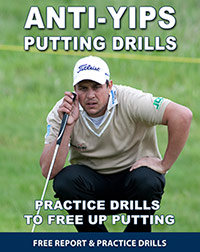
Winning the Battle of the Mind in Golf
What words describe how you feel in the moments before you hit a short putt?
Tentative? Anxious? Fearful? Doubtful? Scattered? Overwhelmed?
Do you second-guess yourself even though the putt is not particularly difficult?
These are the feelings and words golfers use to describe their experience when entrenched with the yips.
Now, let’s make an important distinction…
You may very well feel nervous when you are putting during a playoff or trying to save par late in a round. In that situation, a little bit of nervousness is quite normal.
The yips are a whole different ballgame…
As mentioned previously, the yips are a condition that is entrenched, developed over a period of time.
The yips are, then, a habit or a cycle that affects your attitude, belief, physiology and performance. That is why the yips cycle seems so difficult to break.
What is the Yips Cycle?
The yips cycle is a vicious cycle that interferes with your ability to golf at a high level and challenges your mental fortitude over a significant period of time.
Here’s the cycle:
- PAST YIPS OR MISSING–>
- FEAR OF MISSING AGAIN–>
- AVOID EMBARRASSMENT–>
- OVER-CONTROL STROKE –>
- YIP OR NO FREEDOM –>
- I’VE FAILED AGAIN–>
- EMBARRASSMENT–>
- OTHERS SEE ME FAIL–>
- I’M A FAILURE–>
- FRUSTRATION–>
- FIX/TINKER –>
- START CYCLE AGAIN–>
In fact, many golfers would rather deal with a nagging injury than the feeling of being mentally trapped by the yips.
You are not the only golfer who has gone through the yips.
To illustrate the yips cycle, let’s use the example of Aaron H…
Aaron was a successful high school golfer who was offered a college scholarship to play golf at the Division I level…
Aaron was a solid putter who always could rely on that part of his game to make up some strokes during a round.
In his sophomore season in college, Aaron started missing easy putts time after time.
Each putt became harder and harder for Aaron.
When faced with a 4-foot putt, memories of past misses would flood his mind.
Fear of missing another putt would dominate his thoughts.
Aaron was nervous to let his team down and wanted to avoid the embarrassment of missing putts that he easily sank in the past.
Aaron would grip the putter a little tighter and try to push the ball towards the hole but his body would jerk and he would miss AGAIN.
Aaron would be overwhelmed by thoughts of failure, “I can’t believe I keep failing.”
Negative emotions well up inside and “I failed” turns into “I’m a failure” as he walked to the ball for another ‘disastrous’ attempt… And so the yips cycle continues.
In fact, many golfers would rather deal with a nagging injury than the feeling of being mentally trapped by the yips.
How the Yips Affect Golfers
The yips are a stress on you technically, physically, and mentally and are accompanied with a deep emotional component.
When these four components join forces, the yips can seem like an insurmountable obstacle.
1. Technically – This is the most obvious component of the yips. Your stroke becomes uncomfortable and forced. You can’t seem to hit the ball with any consistency and easy shots become excessively difficult. Many golfers try to tinker with their technique or change clubs to get their swing back but are mostly unsuccessful with this approach.
2. Physically – The yips have a great impact on your physiology which adversely affects your swing and how you contact the ball. Increased muscle tension, rapid heart rate, shallow breathing, muscle twitches, upset stomach, lowered energy levels and excessive sweating interfere with your ability to concentrate and consistently hit the ball with a smooth, fluid stroke.
3. Mentally – The mental aspect of the yips is the most daunting component. Anxiety, inability to focus, lack of trust in your ability to make good shots, negative thoughts, low confidence and fear raise the level of difficulty exponentially. It is the mental clutter that decimates a golfer. Negative thoughts bombard your brain: “What is wrong with me?” “What if I miss this easy putt?” “What will others say behind my back?” “I should just give up!” This isn’t worth it!” The mental component is the component that keeps you trapped in the yips cycle.
4. Emotionally – The yips evoke profound negative emotions such as: embarrassment, frustration, anger, despondence, uncertainty, hopelessness and resignation. All perceived negative events are accompanied with intense, unproductive emotions. These intense negative emotions become triggers that keep the yips cycle in motion.
As you can see, the yips are a tribulation that cause many golfers to seriously consider quitting the sport altogether.
You are not the only golfer who has gone through the yips. It happens to players on the Tour, too.
For example, Jason Dufner has been having difficulty with short putts during the 2018 season.
Dufner has been talked about in the same sentence as the yips.
Whether he agrees with having the yips or not, Dufner has looked extremely uncomfortable over short putts.
As pressure mounts, Dufner has more difficulty sinking short putts.
This season, Dufner has performed well on Saturdays, ranking 26th-best on the greens. On Sundays, the story changes dramatically with a ranking of just 202nd.
One noticeable fact is the length of time it takes Dufner to putt which is characteristic of many golfers experiencing the yips.
At times, it takes Dufner over twice as long (21 seconds) to strike the ball when standing over a putt as compared to other players on the Tour.
This normally indicates that a golfer is overthinking their shot, over-analyzing technique, projecting the possible results of their shot, catastrophizing the situation and lacking trust in their ability to perform successfully.
Dufner assessed the current status of his putting and feels he is on the road to improvement.
DUFNER: “Week-to-week it’s a little indifferent, but over the course of the year I think I’ve been doing really well with it. I feel like it’s starting to become more natural, but there’s times that obviously I wish it was better than others. But I like where I’m at. I think I’m physically and mentally the best I’ve ever been with that part of my game.”
Golf is a challenging game but at times, golfers make it more difficult than it needs to be.
As Dufner alluded to, you need to be at your best mentally and physically to play your best.
When you are mentally on top of your game, you can neutralize the effects of the yips, break the yips cycle or avoid the yips altogether.
Winning the Battle of the Mind
Overthinking and over-analyzing is what keeps you stuck in the yips cycle.
You want a routine that helps you simplify your putting or chipping, not try harder to make a good stroke.
The only thing that’s important to focus on over the ball is your pace or the target. You’re body will do the rest.
Get out of your own way so your intuitive mind can do what it already knows how to do.
Ken Ravizza would always say: “To gain control, you have to give up control.”
Related Golf Psychology Articles
- Can Golfers Overcome the Yips?
- How Danielle Kang Overcame the Yips
- How to Overcome Anxiety Before Golfing
Anti-Yips Putting Drills

Do you spend most of your practice time trapped by stroke or mechanics on the practice green? Are you unsure how to practice to help you overcome the putting yips?
With my exclusive drills to free up your putting, previously available to my personal coaching students, you can learn how to use your mind to help you improve your putting performance.
Download my FREE putting report and drills to help you unlock your putting potential today! Please complete the form below to immediately download my FREE putting practice drills:

I have the chip and putting yips. Hit the ball fairly well until I get around or on the greens. Help
What happens on the course to your stroke?